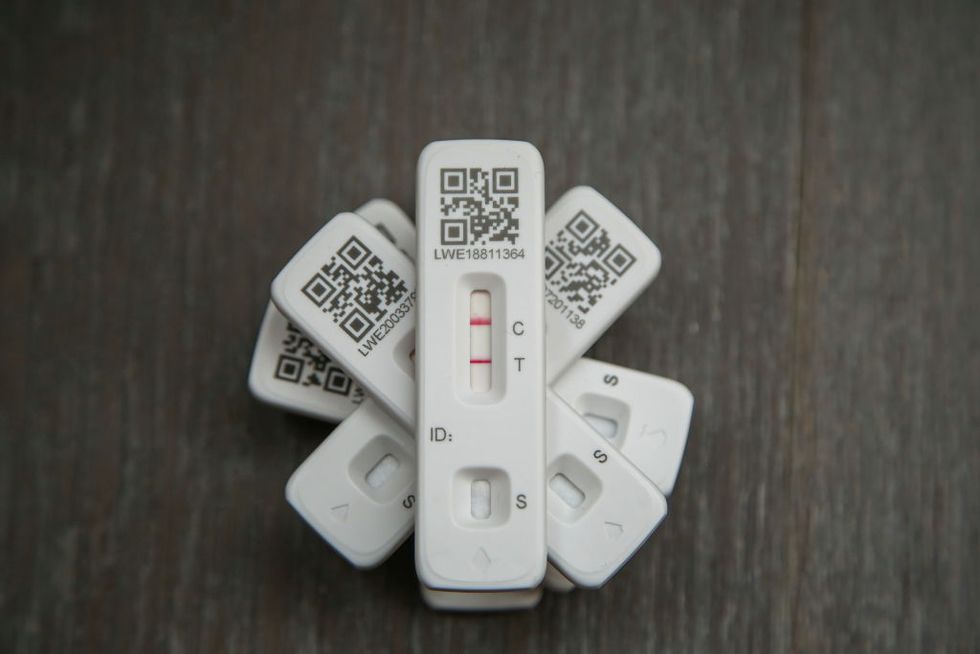Fitness
Running after Covid: When is it safe to start running again?

More than four years have passed since the first cases of Covid were reported. For some, the pandemic is a distant memory or fever dream. For others, it is still very much a horrible presence in their lives. Cases still surround us, and although for most people the illness is now relatively brief and mild, for others it ushers in a long-term nightmare. Around 65 million people around the world may now be living with long Covid – and plenty of others struggle in the medium term after contracting the virus.
But, the past few years have also triggered intensive research on the infection, and we now have a much better understanding on what Covid does to our immune systems, our exercise habits and our bodies as a whole. So, what do studies say about running with, and after, Covid?
Can you exercise with Covid?
A positive test for Covid should mean, in the short term, a pretty straightforward red flag for any intensive exercise. In May 2023, a review published in Frontiers in Physiology looked at existing studies to determine if high-intensity activity could be dangerous for someone with Covid.
Of course, in the long term, intense exercise has many benefits for our general health. However, the paper concluded that intensive exercise during and after a Covid infection influences the levels of stress hormones (adrenaline, noradrenaline and dopamine) in the body, which in turn may make Covid symptoms more severe.
Back in October 2020, a panel of experts published a return-to-sport pathway – the Graduated Return To Play (GRTP) protocol – in the British Medical Journal. It determined that all athletes testing positive for Covid – including professionals and Olympians – should have a minimum of 10 days’ rest, and be symptom-free for seven days before they start running again – which they should do very gradually. This applied to totally asymptomatic cases, too.
Caution, in other words, was vital – and, in many ways, this advice still holds. If there is one thing we know about Covid, it is that it can be unpredictable. Most doctors agree that it is far better to take a few extra days away from exercise than risk causing more problems later down the line. It is important to remember that Covid is not like a common cold or flu – it induces an inflammatory response in the body which those viruses do not bring, and should be treated differently.
If you have an acute Covid infection, hold fire on any exercise until you are testing negative and no longer feel any symptoms. Then, start by going for a walk. If your heart rate goes up more than it typically does, you may need to take more rest days. It’s also worth watching out for changes in your fitness tracker, if you wear one. A 2022 paper published in Lancet Respiratory Medicine found that changes in resting heart rate, sleep and heart rate variability can actually allow wearables to detect Covid before their users even test positive. By the same token, they can be used to indicate progress back to full health.
When can I start exercising after Covid?
Even once you feel well enough to exercise, it can still be difficult to gauge how hard to push yourself – especially since many people feel lingering effects for some weeks after first testing positive for Covid.
The 2023 Frontiers in Physiology review suggests that ‘low to moderate resistance and endurance training is a more effective and well-tolerated intervention in post-Covid’, although it also notes that this lower intensity exercise may not be sufficient to actually improve ‘physiological limits’.
In other words, there is a tightrope to tread between returning to fitness and stressing the body to such an extent that lingering symptoms are worsened, or stay around for longer. And so, there is no definitive answer as to when you should start to run, or start to run harder, after Covid. The most important thing is to listen to your body and respect the signals that it is giving you.
Dr James Hull, a consultant respiratory physician at Royal Brompton Hospital and the Institute of Sport, Exercise and Health, worked with Team GB athletes in their preparation for the Olympic Games in Tokyo. He was also on a panel of experts advising the International Olympic Committee.
‘In the early stages of Covid, we were advising people with it to not exercise for fear of the potential that their immune system could be modulated by vigorous exercise, which could possibly make them more vulnerable to deterioration,’ explains Hull. ‘Hence the guidelines of leaving at least 10 days with no exercise at all.’
But, according to Hull, much has changed since then. ‘First, we know that the incidence of myocarditis [inflammation of the heart muscle] is much lower, so that risk is reduced. Second, we know that it’s a rare occurrence for an athletic individual to be hospitalised or to develop serious problems. Third, we’ve got vaccines in place, which effectively modulate the disease course and make it a far milder condition.’
What’s more, Olympic rules have changed. In Tokyo in 2021, athletes were subject to frequent Covid testing and had to compete in empty stadiums and arenas, as fans were not allowed to attend. In Paris in 2024, there was no rule stating that Covid-positive athletes must not compete – instead, it was down to them to decide whether they carried on or not.
Do different symptoms require different recovery periods?
There’s an often-repeated piece of folk wisdom that says you can probably crack on if the symptoms of your virus stay above your neck. Below your neck, rest. Is it true?
Hull laughs. ‘There was absolutely no data or basis to support that, but I led a publication in the British Journal of Sports Medicine looking at our experience of Covid in Team GB athletes preparing for Olympic and Paralympic competition. We found that those individuals who had symptoms that were localised above the neck actually did have a quicker recovery and were far more likely to get back to feeling fully back to sport, as opposed to those who had symptoms below the neck – in other words, the presence of breathlessness or chest pain.’
Generally, you should always be aware of what your individual Covid symptoms are telling you and never ignore any red flags. ‘If you have any chest pain, palpitations, inappropriate dizziness or shortness of breath associated with chest tightness, then stop,’ says Hull. ‘But if you feel up to it, you can restart light exercise, such as a light jog – but keep your heart rate below 60% or 70% of its maximum.’
What is the best exercise to do post-Covid?
It’s important to stress, as Hull does, that you must not to ignore warning signs or take generic advice over what’s right for you. As always, listen to your body. But, for those who experience relatively light or asymptomatic Covid – which, thankfully, is the vast majority of us – then it’s fine to return to light exercise relatively soon.
Light, however, really does mean light – keeping your heart rate low and never trying to make up for missed sessions. Realistically, just a couple of days off may not be nearly long enough for many. The recovery period from Covid is variable and some symptoms are more persistent than others.
Is it normal to feel bad when running after Covid?
If you love running as much for the mental health benefits as the physical, it’s reassuring to know that you can return to running pretty soon – with caution – if all feels well. That said, Covid symptoms are often frustratingly inconsistent. While you might feel good enough to attempt a run, when you get out there, you can then feel terrible.
One reason why returning to running might feel harder than expected can be found in some fascinating research by Dr Jennifer Radin, an epidemiologist at the Scripps Research Translational Institute in California. Before Covid hit, she was working on a project using data uploaded from users of wearable Fitbit technology to predict the spread of flu in real time. By identifying the proportion of users each week who had abnormal data on metrics such as resting heart rate, the researchers could predict flu-like illness.
As such, Dr Radin and her colleagues were in the perfect position to apply this approach to the Covid epidemic. They created an app where users in the USA and Australia could share data from their Fitbit, Garmin or Apple Watch and log Covid test results, or other illnesses and symptoms. This allowed tracking metrics – sleep, resting heart rate, step count and so on – before, during and after Covid.
The results were fascinating. ‘Users who tested positive for Covid were sleeping more – even more than users who were sick but tested negative,’ explains Radin. ‘We also saw larger changes in their daily step counts and resting heart rates compared with those individuals who were symptomatic but tested negative, so had some other sort of respiratory infection.’
The Covid effect was most marked in resting heart rate. While healthcare professionals will consider anything between 60 to 100 beats per minute as ‘normal’, wearables track a user’s unique patterns over time and, as a result, are a great data source for that individual’s actual recovery.
The data gathered on the app showed that the resting heart rate of an average Covid-positive individual did not return to normal for 79 days. In those with other illnesses, it was just four days. Plus, 14% of Covid patients did not return to their normal resting heart rate for more than 133 days.
Is it normal to lose stamina after Covid?
For many, a slightly elevated resting heart rate might not even be noticeable. But, runners who use their heart rate for training may start to recognise what has become an extremely common pattern – while they may feel well enough to run, their heart rate is higher than they would expect when doing so. Everything is suddenly recalibrated, and running at a pace that previously might have peaked at 80% of your maximum now starts at that level. Easy efforts suddenly become steady, while steady efforts become hard and hard becomes impossible. It can feel like you’re considerably less fit and have less stamina than before. So why does this happen?
‘It seems likely that this goes back to some sort of inflammation, and to the impact of the autonomic nervous system that has been found in many Covid study participants and patients, where they have trouble regulating their heart rate,’ says Radin.
Hull echoes her. ‘We don’t know the answer yet, but it’s probably multifactorial and explained by some dysregulation of the autonomic control of heart rate. Potentially, there are inflammatory changes and also some detraining from a recovery period – but it’s a consistent and very common finding I’m seeing in athletes, and runners and cyclists in particular.’
Another pattern highlighted by Radin’s research was that Covid recovery is not linear. ‘Our study and other similar ones found that, on average, people had this initial increase in their resting heart rates that peaked – then their heart rate was actually lower than average, and then it went back up again after nine or 10 days,’ says Radin. ‘We don’t know exactly what’s causing this, but we think that there’s potentially some impact to people’s autonomic nervous system – so, how their heart rate is regulated. There’s still much that we don’t understand.’
Radin’s study concluded that the results showed the ‘prolonged physiological impact of Covid infection, lasting for approximately two to three months on average, but with substantial intra-individual variability’. In layman’s terms, Covid is most definitely not just a cold – and while you might be back on your feet soon, you may find that it takes you much longer to get to the point where those feet move at the same speed as before.
So, today, the messages on Covid are somewhat mixed. If you feel alright, then yes, you can return to gentle exercise sooner than you might have thought. On the other hand, you might find that it takes you a lot longer to return to your pre-Covid baseline than you hoped – but perhaps you’ll be reassured by the findings that this is very ‘normal’.
What are the more serious possible complications of Covid?
Be assured that serious complications associated with Covid are rare.
Take myocarditis, for example, which Hull says is much less prevalent than initially thought. In September 2020, a US study published in JAMA Cardiology found evidence for myocarditis in 15% of 26 college athletes who tested positive for Covid. But, a larger study in May 2021 found just 2.3% – and some of those cases were ‘subclinical’ and only diagnosed after extensive testing.
Another fortunately rare but potentially serious complication post-Covid is blood clotting. ‘The warning signs are sharp, stabbing pains in the chest,’ says Hull. ‘If it feels like you are being stabbed with a needle, or if you get a swollen unilateral [one side] calf, such as a deep vein thrombosis (DVT), you should be very cautious. It might not reflect an injury or a tear or pull. Your blood is more sticky when you’ve got Covid, so you’ve got to be careful if you do have a clot not to assume that it’s something else.’ If you suspect a clot, seek medical help as soon as possible.
And what about your lungs? In rare cases, Covid can cause pneumonia and even acute respiratory distress syndrome. So, some runners might be nervous about giving those lungs a hard workout post-Covid. But one thing we do know now is that those who are physically fit and exercise regularly are giving themselves a huge advantage.
‘In general, with data we see of people coming out of Covid, there seems to be a prevalence of somewhere between 2% and 5% who have protracted changes [to their lungs] on X-rays and CT scans,’ says Hull. ‘But my experience with athletes is that just doesn’t occur. I can’t think of a single athlete where I’ve seen protracted lung changes, and I’m not aware of any literature that has suggested otherwise. It was a concern at the start of the pandemic, certainly – but it hasn’t been something I’ve seen in reality.’
Hull has, however, worked with athletes who have developed breathing ‘disorders’ after Covid. ‘When we investigate that group, there’s quite a high proportion who have what looks like dysfunctional breathing, or what we might term a breathing pattern disorder,’ she notes. ‘That’s a form of condition where people tend to breathe more through the upper part of their chest or the apices of their lungs. And it becomes very inefficient, because the gas exchange part of the lung is at the bottom.’ To help athletes in this group, respiratory therapists work on breathing techniques – a little like the diaphragmatic breathing that yoga regulars may have practised.
While such breathing disorders are deeply frustrating for athletes, whose livelihoods depend on performances, the key thing to remember is that moderate exercise still helps to boost our immune function. A study published in the British Journal of Sports Medicine concluded that meeting the physical activity guidelines – and having a greater level of fitness – decreases the likelihood of severe Covid infection. ‘Physical fitness protects us from hospitalisation, the development of complications, the development of lung fibrosis and potentially provides a more rapid recovery from illness,’ says Hull.












